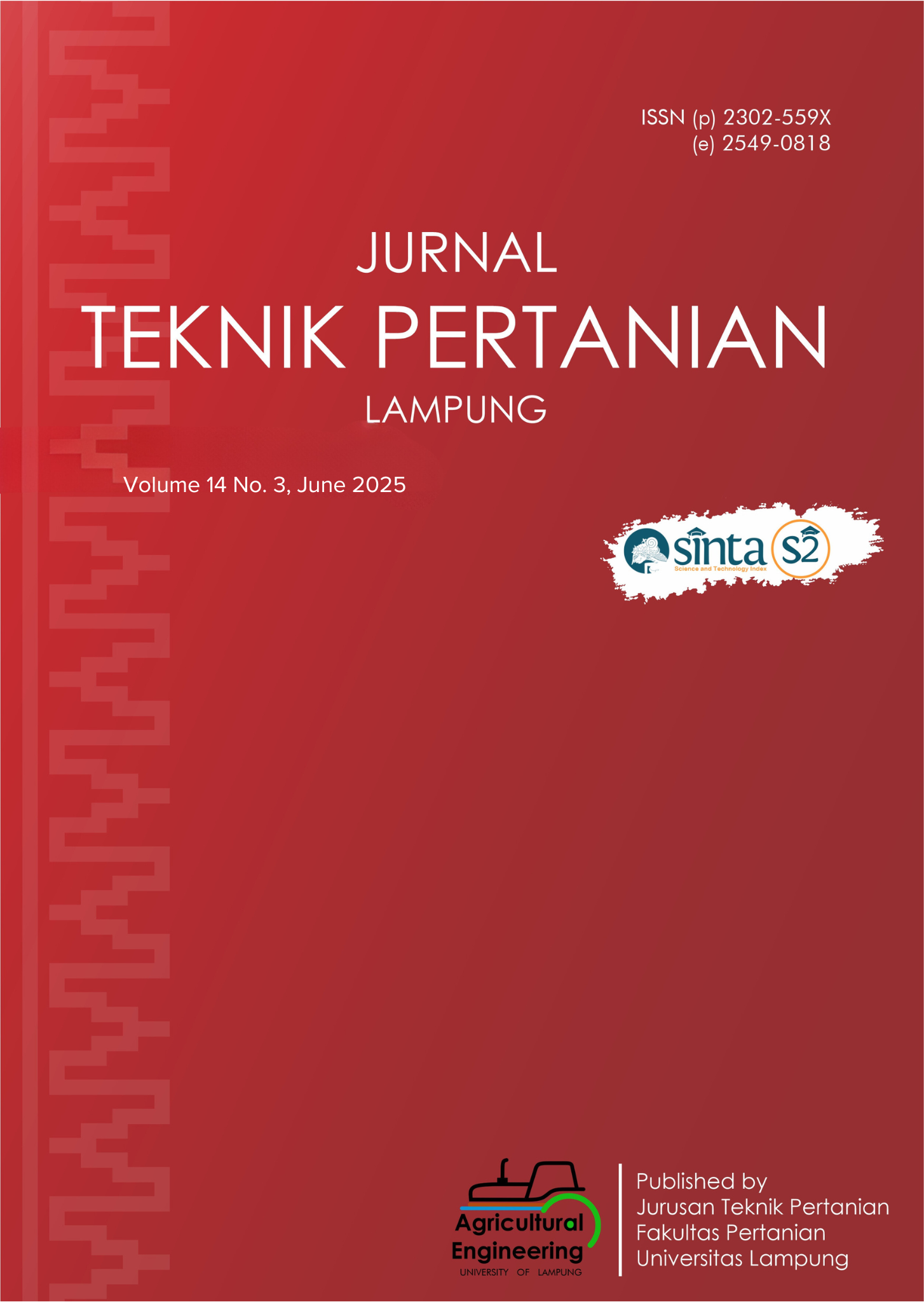Secondary Metabolites of Babandotan (Ageratum conyzoides L.) and Putri Malu (Mimosa pudica L.) to Control Fall Armyworm (Spodoptera frugiperda)
DOI:
https://doi.org/10.23960/jtep-l.v14i3.887-898 Abstract View: 219
Abstract View: 219
Abstract
Corn (Zea mays) production in Indonesia has experienced fluctuations due to infestations of the fall armyworm (Spodoptera frugiperda). Utilizing botanical pesticides derived from Ageratum conyzoides (Babandotan) and Mimosa pudica (Putri Malu) is a method to control the fall armyworm and maintain stable corn production. This study aims to identify the active compounds and determine the effective concentration of A. conyzoides and M. pudica extracts in reducing S. frugiperda populations. The research was conducted from June to November 2024 at the Pest Laboratory of the UPT Plant Protection Unit in Surabaya. The study was designed using a Completely Randomized Design with a single factor: different concentrations of plant extracts, replicated five times. Observed parameters included phytochemical tests, GC-MS compound screening, larval symptoms, mortality rate, pupae formation, and imago formation. The results showed that A. conyzoides and M. pudica extracts at the highest concentration (1%) significantly affected mortality rates, pupation, and adult emergence. Both extracts contained flavonoids, tannins, and triterpenoids, which effectively controlled S. frugiperda populations.
Keywords: Bioinsecticide, Spodoptera frugiperda, Zea mays.
Downloads
References
Abdullah, R.R. (2019). Insecticidal activity of secondary metabolites of locally isolated fungal strains against some cotton insect pests. Journal of Plant Protection and Pathology, 10(12), 647–653. https://doi.org/10.21608/jppp.2019.79456
Adebayo, A., Zeng, G.-Z., Zhang, Y., Ji, C., Akindahunsi, A., & Hua, N. (2010). Toxicological evaluation of precocene II isolated from Ageratum conyzoides L. (Asteraceae) in Sprague Dawley rats. African Journal of Biotechnology, 9(20), 2938-2944.
Anggraini, D., & Rustam, R. (2023). Efektivitas berbagai konsentrasi ekstrak daun sirih hutan (Piper aduncum L.) dalam mengendalikan ulat grayak jagung. Jurnal Agroteknologi, 13(2), 77-84. http://dx.doi.org/10.24014/ja.v13i2.17600
Aprianti, F., Hidayat, Y., & Dono, D. (2022). Pengaruh ukuran partikel sulfur terhadap mortalitas, pertumbuhan dan perkembangan ulat grayak jagung Spodoptera frugiperda J.E. Smith (Lepidoptera: Noctuidae). Agrikultura, 32, 257-265. https://doi.org/10.24198/agrikultura.v32i3.35270
Badan Pangan Nasional Republik Indonesia. (2023). SK Pedoman Klasifikasi Pangan Segar (No. 0, pp. 1–23). Balfas, R., & Willis, M. (2009). Pengaruh ekstrak tanaman obat terhadap mortalitas dan kelangsungan hidup Spodoptera litura F. (Lepidoptera: Noctuidae). Buletin Penelitian Tanaman Rempah dan Obat, 20(2), 148–156.
Barbehenn, R.V., & Constabel, C.P. (2011). Tannins in plant–herbivore interactions. Phytochemistry, 72(13), 1551-1565. https://doi.org/10.1016/j.phytochem.2011.01.040
Biessmann, H., Andronopoulou, E., Biessmann, M.R., Douris, V., Dimitratos, S.D., Eliopoulos, E., Guerin, P.M., Iatrou, K., Justice, R.W., Kröber, T., Marinotti, O., Tsitoura, P., Woods, D.F., & Walter, M.F. (2010). The Anopheles gambiae odorant binding protein 1 (AgamOBP1) mediates indole recognition in the antennae of female mosquitoes. PloS One, 5(3), e9471. https://doi.org/10.1371/journal.pone.0009471
Bishr, M., & Salama, O. (2018). Inter and intra GC-MS differential analysis of the essential oils of three Mentha species growing in Egypt. Future Journal of Pharmaceutical Sciences, 4(1), 53-56. https://doi.org/10.1016/j.fjps.2017.08.003
Bosi, C.F., Rosa, D.W., Grougnet, R., Lemonakis, N., Halabalaki, M., Skaltsounis, A.L., & Biavatti, M.W. (2013). Pyrrolizidine alkaloids in medicinal tea of Ageratum conyzoides. Revista Brasileira de Farmacognosia, 23(3), 425–432. https://doi.org/https://doi.org/10.1590/S0102-695X2013005000028
Cali, K., Tuccori, E., & Persaud, K.C. (2020). Chapter Eighteen - Gravimetric biosensors. Methods in Enzymology, 642, 435–468. https://doi.org/10.1016/bs.mie.2020.05.010
Fadlian, Hamzah, B., & Abram, P.H. (2016). Uji efektivitas ekstrak tanaman putri malu (Mimosa pudica Linn) sebagai bahan pengawet alami tomat. Jurnal Akademika Kimia, 5(4), 153–158.
Francikowski, J., Potrzebska, M., Szulińska, E., Tarnawska, M., Radai, Z., Łozowski, B., Baran, B., & Krzyżowski, M. (2021). The effects of high-monosaccharide diets on development and biochemical composition of white-eyed mutant strain of house cricket (Acheta domesticus). Scientific Reports, 11(1), 21147. https://doi.org/10.1038/s41598-021-00393-5
Giovanny, L., Lestari, F. A., Marfira, N., Ambarsari, L., & Warnasih, S. (2019). Potency of ethanol extracts of palm seeds (Phoenix dactylifera as antidiabetic with inhibition kinetics parameter. Current Biochemistry, 6(2), 55–67. https://doi.org/10.29244/cb.6.2.1
Guswenrivo, I., Tarmadi, D., & Yusuf, S. (2013). Aktivitas insektisida ekstrak buah bintaro (Cerbera manghas) terhadap kutu beras Sitophilus oryzae (Coleoptera: Curculionidae). Jurnal Ilmu Dan Teknologi Kayu Tropis, 11(1), 64–90.
Harborne, J.B. (1996). Phytochemical methods: a guide to modern techniques of plant analysis. Chapman and Hall. Harborne, J.B., & Williams, C.A. (2000). Advances in flavonoid research since 1992. Phytochemistry, 55(6), 481–504. https://doi.org/10.1016/S0031-9422(00)00235-1
Hernani, & Raharjo. (2005). Tanaman Berkhasiat Antioksidan. Penebar Swadaya, Jakarta.
Jaszczak, E., Polkowska, Ż., Narkowicz, S., & Namieśnik, J. (2017). Cyanides in the environment-analysis-problems and challenges. Science and Pollution Research International, 24(19), 15929–15948. https://doi.org/10.1007/s11356-017-9081-7
Kamboj, A., & Saluja, A.S. (2008). Ageratum conyzoides L.: A review on its phytochemical and pharmacological profile. International Journal of Green Pharmacy, 2(2), 59-68.
Kurniawan, A., Muhfahroyin, M., & Sutanto, A. (2021). Efektivitas variasi konsentrasi ekstrak daging buah bintaro sebagai insektisida lepidoptera pada bawang daun sebagai sumber belajar pencemaran lingkungan. BIOLOVA, 2(1), 54–63. https://doi.org/10.24127/biolova.v2i1.323
Mengkido, M., Lambui, O., & Harso, W. (2019). Uji daya hambat ekstrak daun bandotan (Ageratum conyzoides L.) terhadap pertumbuhan bakteri Staphylococcus aureus. Biocelebes, 13(2), 121–130.
Mithöfer, A., & Boland, W. (2012). Plant defense against herbivores: Chemical aspects. Annual Review of Plant Biology, 63(1), 431–450. https://doi.org/10.1146/annurev-arplant-042110-103854
Morimoto, M., & Komai, K. (2006). Insect antifeedant activity of natural products and the structure-activity relationship of their derivatives. In Natural Products for Pest Management (Vol. 927). American Chemical Society, Washington, DC 20036: 182 193. https://doi.org/10.1021/bk-2006-0927.ch014
Mukti, A.N.K., Rahmadhini, N., & Triwahyu, E. (2024). Pengaruh pestisida nabati daun kemangi untuk pengendalian hama Spodoptera frugiperda (Lepidoptera : Noctuidae) pada tanaman jagung. Biofarm, 20(1), 44–49.
Munira, M., Rodisa, F., & Nasir, M. (2020). Uji antibakteri kombinasi ekstrak daun Biduri (Calotropis gigantea L.) dan daun Bandotan (Ageratum conyzoides L.). Jurnal SAGO Gizi Dan Kesehatan, 1, 165-171. https://doi.org/10.30867/gikes.v1i2.410 National Center for Biotechnology Information. (2025). PubChem Compound Summary for CID 8973, 3-O-Methylglucose. https://pubchem.ncbi.nlm.nih.gov/compound/3-O-Methylglucose
Nonci, N., Kalgutny, Hary, S., Mirsam, H., Muis, A., Azrai, M., & Aqil, M. (2019). Pengenalan Fall Armyworm (Spodoptera frugiperda J.E. Smith) Hama Baru Pada Tanaman Jagung Di Indonesia. Balai Penelitian Tanaman Serealia, Badan Penelitian dan Pengembangan Pertanian, Kementerian Pertanian, Jakarta.
Pohan, D.J., & Yang, J.J. (2024). Effect of putri malu (Mimosa pudica Linn) leaf extract as an inhibitor of vibrio cholerae growth. Journal of Complementary and Alternative Medical Research, 25(2), 1–9. https://doi.org/10.9734/JOCAMR/2024/v25i2514
Robinson, T. (1995). Kandungan Senyawa Organik Tumbuhan Tinggi (Translated by Kosasih Padmawinata). ITB Press, Bandung.
Rohimatun, Aisyah, M.D.N., Ahyar, & Wahyudi, S. (2021). Babadotan (Ageratum conyzoides L.) sebagai insektisida nabati. Wartabalittro, 38(76), 14–19. https://www.researchgate.net/publication/352838361
Rustam, R., & Rajani. (2021). Uji beberapa konsentrasi ekstrak akar tuba (Derris elliptica Benth) untuk mengendalikan hama ulat grayak (Spodoptera frugiperda J.E. Smith) di laboratorium. Jurnal Agrotek, 5(1), 24–33. https://doi.org/10.33096/agrotek.v5i1.156
Surahmaida, S., Sudarwati, T.P.L., & Junairiah, J. (2019). Analisis GCMS terhadap senyawa fitokimia ekstrak metanol Ganoderma lucidum. Jurnal Kimia Riset, 3(2), 147–155. https://doi.org/10.20473/jkr.v3i2.12060
Syarifah, R.N.K. (2020). Pemanfaatan gulma mimosa invisa sebagai pengendali organisme pengganggu tanaman. Biofarm : Jurnal Ilmiah Pertanian, 16(2), 59-67. https://doi.org/10.31941/biofarm.v16i2.1207
Tarigan, W.Y.B., Siregar, S.D., & Hartono. (2024). Hubungan faktor pendidikan, pelatihan, pengetahuan, ekonomi dan penggunaan APD dalam penggunaan pestisida di Desa Cinta Rakyat Tahun 2023. Jurnal Kesehatan Tambusai, 5(3), 8259–8265.
Vargas-Méndez, L.Y., Sanabria-Flórez, P.L., Saavedra-Reyes, L.M., Merchan-Arenas, D.R., & Kouznetsov, V.V. (2019). Bioactivity of semisynthetic eugenol derivatives against Spodoptera frugiperda (Lepidoptera: Noctuidae) larvae infesting maize in Colombia. Saudi Journal of Biological Sciences, 26(7), 1613–1620. https://doi.org/10.1016/j.sjbs.2018.09.010
Wu, Z., Wei, W., Cheng, K., Zheng, L., Ma, C., & Wang, Y. (2020). Insecticidal activity of triterpenoids and volatile oil from the stems of Tetraena mongolica. Pesticide Biochemistry and Physiology, 166, 104551. https://doi.org/https://doi.org/10.1016/j.pestbp.2020.02.017
Yallac, F.I., Novi, C., & Abdilah, N.A. (2022). Efikasi biopeptisida ekstrak Etlingera elatior (Jack) R.M.SM. terhadap mortalitas larva Spodoptera litura. Jurnal Medika & Sains, 2(2), 103-112.
Zagrobelny, M., Bak, S., Rasmussen, A.V., Jørgensen, B., Naumann, C.M., & Lindberg Møller, B. (2004). Cyanogenic glucosides and plant-insect interactions. Phytochemistry, 65(3), 293–306. https://doi.org/10.1016/j.phytochem.2003.10.016
Downloads
Published
How to Cite
Issue
Section
License
Authors who publish with this journal agree to the following terms:
Authors retain copyright and grant the journal right of first publication with the work simultaneously licensed under a Creative Commons Attribution-ShareAlike 4.0 International Lice that allows others to share the work with an acknowledgement of the work's authorship and initial publication in this journal.
Authors are able to enter into separate, additional contractual arrangements for the non-exclusive distribution of the journal's published version of the work (e.g., post it to an institutional repository or publish it in a book), with an acknowledgement of its initial publication in this journal.
Authors are permitted and encouraged to post their work online (e.g., in institutional repositories or on their website) prior to and during the submission process, as it can lead to productive exchanges, as well as earlier and greater citation of published work (See The Effect of Open Access).
Jurnal Teknik Pertanian Lampung

JTEPL is licensed under a Creative Commons Attribution-ShareAlike 4.0 International License.













